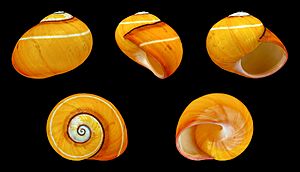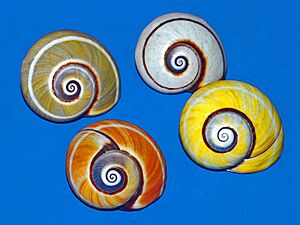Cuban painted snail facts for kids
Quick facts for kids Cuban painted snail |
|
|---|---|
 |
|
| Five views of a shell of Polymita picta, typical colour | |
| Conservation status | |
| Scientific classification |
The Polymita picta, also known as the Cuban painted snail or Oriente tree snail, is a very special type of large, air-breathing land snail. It's a land gastropod mollusk found only in one place.
This snail is the main example of its group, called Polymita. It lives only in Eastern Cuba.
Contents
Where Do Painted Snails Live?
These beautiful snails are found only in Cuba. They live along the northeastern coast, from the ocean inland.
Polymita picta snails are arboreal, which means they live mainly in trees. They prefer certain types of trees in coastal forests, like the Chrysobalanus icaco, Metopium toxifera, Metopium brownei, Bursera simaruba, and Coccoloba retusa trees.
What Do Painted Snails Look Like?
The shells of Polymita picta snails can grow to be about 20 millimetres (0.79 in) long. These shells are very shiny and have bright, amazing colors! Usually, they are bright yellow with a white stripe. However, these snails are famous for having many different shell colors and patterns. This is called polymorphism.
The colors of their shells can change depending on what the snail eats. Some scientists think these varied colors might be a way for the snails to protect themselves from animals that want to eat them. The different colors could confuse predators, making it harder for them to catch the snails.
Sadly, these beautiful shells are sometimes collected illegally to make jewelry and small decorations. Because of this, the Polymita picta has become an endangered species. To protect them, the Cuban government made a law in 1943. This law makes it illegal to take these snails out of Cuba, except for scientific research.
How Do Painted Snails Live?
Polymita picta snails mostly eat lichen, moss, and tiny films of fungi that grow on tree bark and leaves. Their life cycle lasts about 15 months. They usually breed during the wet season, which is around September and October.
When the dry season comes (from December to early May), the snails become dormant. This means they go into a resting state, like a long sleep, to survive the dry weather.
Like most land snails that breathe air, Polymita picta snails have both male and female reproductive parts. This is called being hermaphroditic. However, they cannot fertilize themselves. They need another snail to mate with.
These snails also have a unique mating behavior. They use something called a "love dart." During courtship, they will "shoot" a small, sharp, chalky dart into their partner. This is part of their special way of mating.
Images for kids
See also
 In Spanish: Polymita picta para niños
In Spanish: Polymita picta para niños





